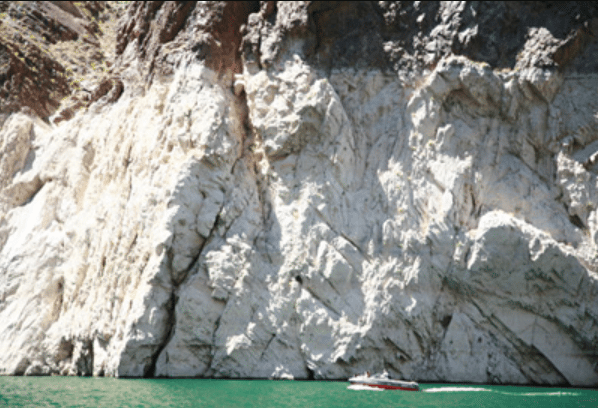Most of the United States will greet the end of winter with relief. In the West, where there has been less snowfall than usual, it will be a cause for anxiety—less snow means less snowmelt, and continued problems for the Colorado River, which has been dangerously depleted by fifteen years of drought. The Colorado provides electricity, irrigation, and drinking water for 40 million people, and all the signs suggest that some of these needs will go unmet in the near future. Lake Mead, the reservoir behind the Hoover Dam, is less than half full. Drawing down the lake has avoided a water shortage so far, but this cannot go on. New projections suggest that there will likely be water shortages on the lower Colorado within two years. Worse, what is being called a drought is likely the new norm: major climatic models almost uniformly predict that the Western United States will face a dry century.
In the last year, these projections have set Colorado River users scrambling. The states of Arizona, California, and Nevada agreed to reduce water consumption to help replenish supplies in Lake Mead. The water districts managing Denver, Las Vegas, Los Angeles, and Phoenix (cities not usually noted for their environmental stewardship) have pooled together money to initiate new planning and conservation efforts. At the same time, the state of Colorado has developed an ambitious Water Plan to hoard every drop of water that the state is not legally obliged to send downstream. Changes in consumption are certainly needed to assure the sustainability of the Colorado. I argue that it will also require a major institutional change. The current legal framework governing the allocation of the Colorado has provided for some measure of interstate cooperation for nearly a century. This same framework also threatens the region’s future.
Like seventeen other rivers in the Western United States, the Colorado is governed by an interstate water compact, a binding multilateral agreement that regulates the River and divides the water into shares for the different states. Interstate water compacts have been an important tool for resource management. Most compacts establish fixed water allocations: each participating state is guaranteed a certain amount of water each year. In wet years on the Colorado, some surplus goes into shared storage in dams run by the federal government, and some is free to be captured by upstream states like Colorado. Predictable water allocations allow for long-term planning. The agreements have allowed states to resolve many issues cooperatively—before the compact system was in place, water disputes were often handled by prolonged litigation or outright violence.
However, the compacts are also old and rigid. The Colorado River Compact, signed in 1922, is effective in perpetuity and provides no clear mechanism for renegotiation. The possibility of a long-term shift in the availability of river water was unforeseen—and its water allocations now look unsustainable. (Temporary guidelines for handling a shortage were adopted in 2007, but these are unsatisfactory, not least because they do not actually specify what actions would be taken during a major shortage.) In addition to the Compact, the Colorado has been silted up by a century of additional agreements and rulings that are collectively known as the Law of the River. Taken in sum, these legal provisions afford little scope for regional authorities to undertake necessary changes.
The environment will compel change whether the law wishes it or not. The question is who will initiate the changes, and who will benefit. As things stand now, a true crisis on the Colorado would be resolved in the Supreme Court, which holds original jurisdiction in interstate compact disputes. This should cause all river users to be wary: the result of a major court ruling is impossible to predict under any circumstances, much less in the midst of a climatic disaster.
The Court generally treats interstate compacts as contracts, and though legal disputes over contracts are numberless, rulings on interstate compacts are relatively rare: there are only a couple dozen water compacts in the United States, and many of them function smoothly. Because there has never been a major delivery shortage on the Colorado, and the governing agreement did not imagine that such a shortage was possible, a court ruling would be needed to resolve a very big open question: what happens to the contract if environmental conditions make it impossible to fulfill? It is hard to predict what the answer might be.
Original jurisdiction cases differ from other cases heard in the Supreme Court. Generally, the facts of a case are produced in a lower court, and the Supreme Court hears an appeal focused on certain questions of law. In an original jurisdiction case, the facts must be developed by the Supreme Court. In water disputes, this is commonly done under the supervision of a Special Master, a court appointee who holds extraordinary power in shaping the outcome of a case. Special masters are typically federal judges themselves, but in water disputes, the appointees are usually scholars or litigators without judicial experience. No formal rules exist to regulate who may be appointed, and once in place, a special master makes many decisions without direct oversight. Those decisions can have a large effect on what questions will be put to the Supreme Court itself. In addition, the legal considerations that judges hold to be important may also differ a great deal from the substantive questions of science and policy that are most relevant to water users—deciding what legal rules regard as just is not the same as determining what is socially desirable. The fate of the Colorado should not be decided on a technicality.
Scholars suggest that a ruling on a catastrophic water shortage could go either way. Upstream states might face crushing damage awards for not sending the required water downstream. Conversely, the Court could declare parts of the Compact unenforceable, leaving downstream states out of luck. In the most extreme case, the Compact could be thrown out entirely, returning the West to an era of fractious disputes and bullying. Whatever happens in court will happen slowly. Kansas spent nearly a century suing Colorado over the Arkansas River. The first Special Master in a dispute over the Pecos River retired before the case was resolved.
Litigation will always be a blunt instrument: it produces a winner and a loser when the process of resource management does not need to be adversarial. The result of a lawsuit would also be constrained by the limitations of a century-old agreement. New challenges on the Colorado would be better handled by experts equipped to formulate policy in light of the present state of scientific knowledge. And, as a democratic principle, the people affected by dwindling supplies of water should have a significant influence on how these challenges are confronted. There is an obvious approach to this problem, though it is not simple: the states, with the consent of the federal government, can negotiate a new Compact. This proposal has been a non-starter in the past. However, the agreements ratified in the last year may herald a moment of greater interstate cooperation in the face of climatic and legal uncertainty. Now could be an ideal moment to strike a New Deal for Western rivers.
A renegotiation could create a stronger commitment to proportional water allocations, which distribute shortages more fairly. Renegotiating could also establish clearer priorities for the use of water. Guaranteeing access to drinking water, for instance, is an issue that transcends the interest of any particular state. Lastly, a new Compact could provide water management agencies with greater flexibility in facing future challenges; if we learned anything from the twentieth century, it is that our institutions need to be adaptable to problems that are not foreseeable at their creation.








